Providence’s Toxic Avenue Leads to Neighborhood Problems
April 22, 2019
PROVIDENCE — A 1.8-mile section of Allens Avenue, from Point Street to New York Avenue, is arguably the most unpleasant stretch of road in Rhode Island.
The territory is marked by a headache-inducing stink, dilapidated buildings, mountains of scrap metal, hills of asphalt, graffiti, chain-link fences, vacant lots and parking lots blazoned with plastic waste, overgrown vegetation that obstructs sidewalks, bicycle lanes covered with grit, heavy truck traffic, idling vehicles, and an unneighborly business that has been giving the finger to the city and state for the past decade.
“It makes me absolutely sick when I drive down Allens Avenue, especially in the summer,” said Linda Perri, a 35-year resident of the area.
The former New York Avenue resident who now lives seven streets to the south on Alabama Avenue mentioned the stench, the dust, the diesel fumes, and the unsightly piles of used metals and asphalt.
The city’s industrial waterfront has been adversely impacting two nearby neighborhoods for generations. The reek and blight are part of a much larger problem, and climate change and the expansion of fossil-fuel infrastructure within the Port of Providence will put the future well-being of South Providence and Washington Park at further risk.
Pointing to the March 2017 derailment of a train transporting 20 tanker cars full of ethanol and a gas leak on Allens Avenue that released roughly 19 million cubic feet of natural gas and an October 2018 tanker truck accident on the Allens Avenue on-ramp to I-95 North that spilled some 5,500 gallons of gasoline, Perri believes the city and/or state needs to commission a Port of Providence comprehensive safety study. She suggested that the city rezone the west side of Allens Avenue from heavy industrial to light industrial and manufacturing and use some of the vacant space there for ground-mounted solar installations.
The concerns of the South Providence and Washington Park neighborhoods, however, have long been met with apathy from city and state officials and from businesses in and around the port.
Even now, Mayor Jorge Elorza continues to praise the city’s industrial waterfront for being a “driver of economic development” and has said publicly he supports maintaining its current uses. Jobs and economic success are no doubt vital, but that shouldn’t give license to create and then foster sacrifice zones.
No one was made available from the mayor’s administration for an interview. The mayor’s press secretary, though, did answer a few questions via e-mail. The answers, for the most part, directed responsibility onto others. Also, none of the answers hinted at any plan to address the public health, climate change, and environmental issues surrounding the Port of Providence.
In response to a question about future plans for the port, its vulnerability to sea-level rise and storm surge, and the health of the two nearby neighborhoods, he wrote: “The City is a partner with ProvPort and there is an interest in ensuring the port’s resiliency to climate change. There is also a focus on a cleaner port that is positioned to better serve the future low-carbon economy. While we defer to ProvPort on specific details, it is our understanding that they are expanding their capacity to service the growing off-shore wind industry and are participating in the Green Marine program.”
ProvPort, however, doesn’t represent all of the businesses operating in and around the Port of Providence, such as Shell, ExxonMobil, National Grid, Sprague Operating Resources LLC, and Rhode Island Recycled Metals. And better serving offshore wind development isn’t the panacea for all of the working waterfront’s woes.
In response to this question — “Why are some businesses operating there not held accountable for breaking environmental regulations with little concern heard from city officials?” — he wrote: “Generally, the City is not responsible for air emissions or coastal regulations. This would be up to RIDEM or CRMC so we defer to them.”
City Council and General Assembly representatives also didn’t make themselves available for an interview.
“We need to start thinking about cleaning up the port, making it cleaner and greener and preventing more pollution in the neighborhood,” said Perri, president of the Washington Park Neighborhood Association. “We need to be using the vacant space down there for solar projects, not to pile up dug-up asphalt and showcase more garbage.”
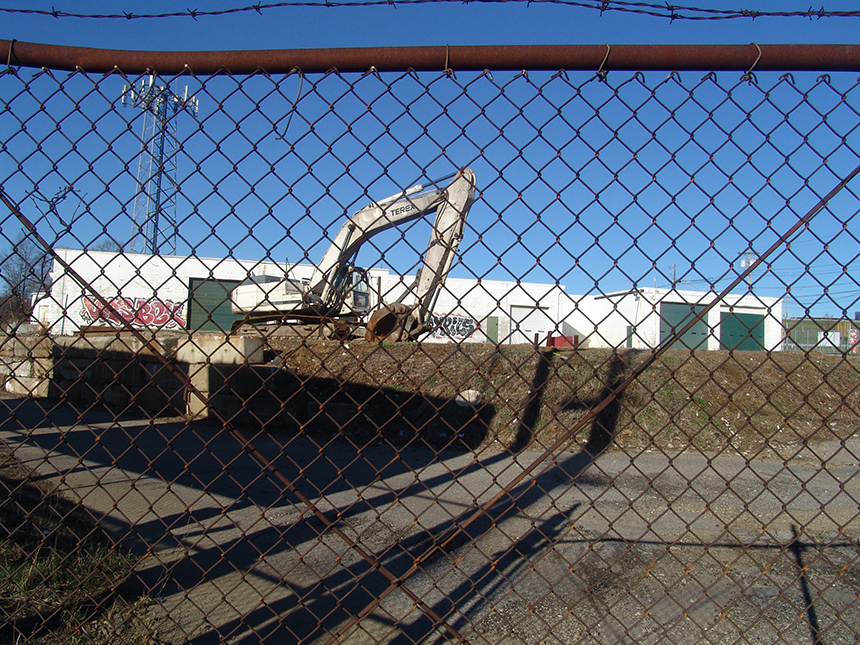
Opposition liquefied
During the past several years, especially when a liquefied natural gas (LNG) project was pushed through — thanks largely to meek elected officials, a governor who forbade the health department from commenting on the controversial facility, and state agencies more concerned about business interests than public safety — South Providence and Washington Park residents began to push back. They raised their voices at public hearings. They created community groups. They protested outside the Statehouse. They organized toxic tours.
This more aggressive resistance got community members seats on recently created stakeholder groups, such as an Environmental Protection Agency (EPA) community working group and another group being led by Brown University called “Building a Resilient Providence.” Perhaps now South Providence and Washington Park residents will be allowed more of a say in the future of their neighborhoods. Their invisible past, however, will continue to haunt them.
For instance, just four years ago, when National Grid announced its proposal to build more LNG infrastructure along the Providence, community concern was met with reassurances that the natural-gas tank would be elevated enough to withstand projected sea-level rise combined with a 100-year storm.
In this age of rising waters and intensifying storm surge, such building specifications are an essential part of any shoreline project, especially one involving fossil fuels.
But for the three years the project was reviewed by local, state, and federal officials — it was approved last fall — the public health impacts of building more polluting infrastructure along the Providence River and upper Narragansett Bay were barely mentioned, despite the fact all 11 of the Providence polluters listed in the EPA’s Toxics Release Inventory Program are within the city’s 02905 zip code.
In fact, this section of the city contains a greater number of polluting facilities than any other zip code in Providence County. All 11 polluters are within a mile radius of National Grid’s latest LNG facility.
Air pollution from the Port of Providence and Interstate 95 has caused the South Providence and Washington Park neighborhoods to endure some of the highest rates of asthma in southern New England — a problem that will get worse as temperatures rise and ozone alert days increase, according to the city’s own Climate Justice Plan. (Rhode Island as a whole has the ninth-highest rate of asthma in the country, with 10.9 percent of the population suffering from the respiratory condition. The national average is 8.4 percent.)
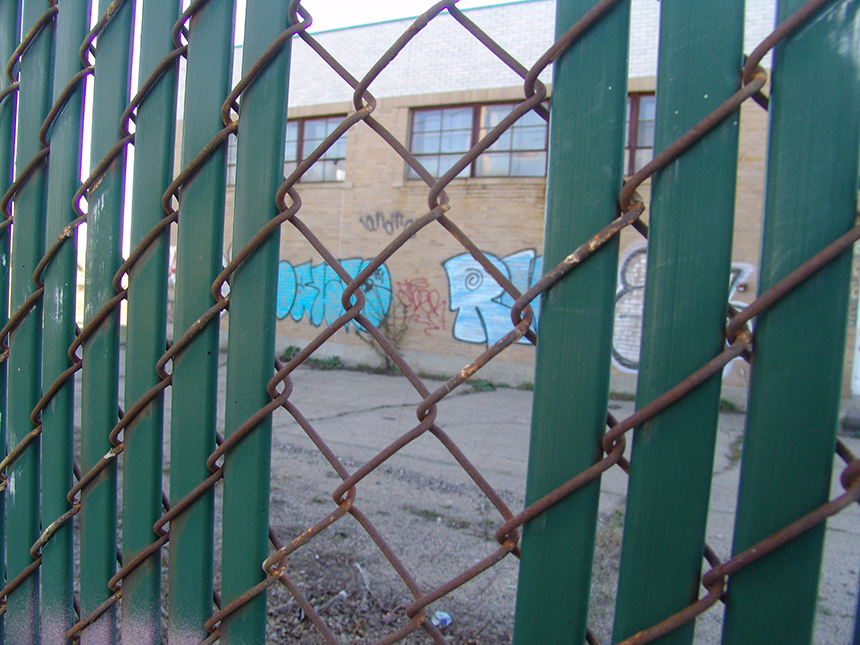
A Rhode Island Department of Health (DOH) letter critical of National Grid’s LNG project noted the many problems already faced by the residents of the two beleaguered neighborhoods.
“The Port of Providence has a long history of environmental problems that concentrate many of Rhode Island’s most concerning pollution and safety issues in neighborhoods that are economically and racially disadvantaged. Because of that history, the residents of the area feel disenfranchised and believe that their voices and health do not matter to government,” according to the three-page DOH letter. “Although the current project does not appear to make those pollution and safety problems substantially worse, it continues that historical pattern of discounting the voices of the people that live in the region and sets a precedent that may lead to additional, more concerning, projects in the future.”
Gov. Gina Raimondo nixed the letter before it was to be submitted to the Federal Energy Regulatory Commission (FERC).
This new LNG facility, being built on a heavily contaminated site that once housed a coal gasification plant and propane and kerosene storage facilities, will add to the port’s collection of imported, exported, and stored petroleum products such as home heating oil, jet fuel, natural gas, and diesel.
National Grid alone operates 2 billion cubic feet of natural-gas capacity at its Fields Point site, providing LNG storage, vaporization, and redelivery services.
Buried in Port of Providence dirt, trapped in sediment, and blowing in the wind are polycyclic aromatic hydrocarbons, total petroleum hydrocarbons, benzene, formaldehyde, cyanide, asbestos, lead, ammonia, arsenic, and polychlorinated biphenyl.
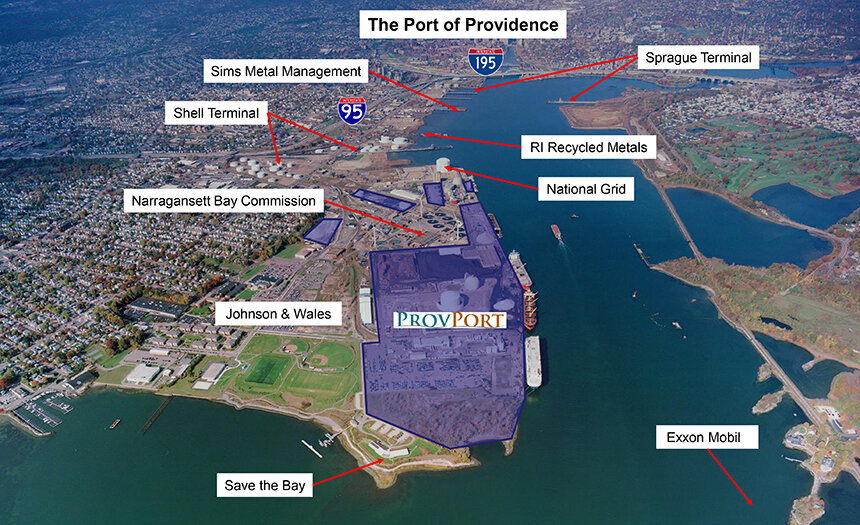
The Port of Providence encompasses a large area — Fields Point to the hurricane barrier to the shores of East Providence. The port is home to Sims Metal Management, Shell’s Providence Terminal, and the Sprague Terminal to the north, National Grid and the Narragansett Bay Commission in the middle, and Save The Bay to the south. ExxonMobil and part of the Sprague Terminal complex are on the East Providence side of the port.
The port is also home to ProvPort, the areas shaded purple in the map above. The 115-acre city-affiliated nonprofit has 10 tenants. Its relationship with the city dates to the mid-1990s. It’s managed by Waterson Terminal Services.
Operations along the Allens Avenue waterfront include a hot-mix asphalt plant that emits compounds linked to child development disorders and to cancer, and an oil terminal that emits similar pollutants and other toxins linked to neurological and respiratory disorders. The port is also home to chemical-processing plants, including Univar USA, a ProvPort packager and distributor of specialty chemicals.
Univar’s waterfront facility has a 14-mile hazard radius — the area that would need to be evacuated in the case of an accident at the plant — because some 3 million pounds of chemicals, such as chlorine, ammonium, and formaldehyde, are stored there.
The area’s nauseating stink isn’t coming from the two Allens Avenue diners that sit between six double-sided billboards.
Sea-level rise, storm surge, and other climate-change impacts, such as flooding caused by more frequent and heavy rains, threaten to unleash more of the port’s nastiness. The city’s industrial waterfront sits outside the Providence hurricane barrier and is one of the region’s most exposed areas to rising waters. Three feet of sea-level rise is projected overwhelm much of the port.
The Federal Emergency Management Agency (FEMA) considers Providence to be the “Achilles heel of the Northeast” because of its position at the head of Narragansett Bay, according to a 2014 study by a University of Rhode Island assistant professor of coastal planning.
“For context, before Hurricane Katrina caused $80 billion in damages to the Gulf Coast, FEMA considered New Orleans to be the Achilles heel of that region,” Austin Becker wrote. “Rhode Island had been hit by nine hurricanes, two of them major, since 1900. The length and orientation of Rhode Island’s Narragansett Bay, and its proximity to the Atlantic hurricane zone, make it susceptible to extreme storm surges from the southerly winds that are generated when a hurricane passes to the west of the Bay.”
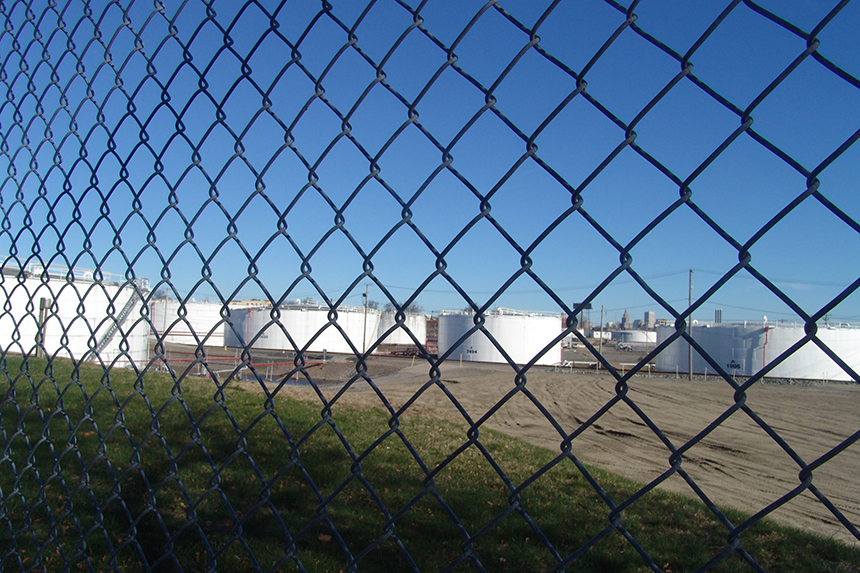
The Conservation Law Foundation (CLF) has sued the Shell Oil Co., which operates a terminal at 520 Allens Ave., for not safeguarding its massive storage facility on Providence Harbor from the impacts of climate change.
“With just one severe storm — one major flood — the Providence River and surrounding communities could be inundated with toxic substances, yet Shell has done nothing to safeguard us from this fate. It’s time they be held accountable for this grave inaction,” CLF president Bradley Campbell said two years ago when the lawsuit was filed.
According to federal flood maps, the fossil-fuel terminal is in a flood zone.
In its civil lawsuit, CLF accuses Shell’s Providence Terminal of being woefully unprepared to address climate change. CLF has claimed that the 75-acre ethanol railcar terminal with 25 storage tanks is failing to address sea-level rise and increased precipitation and damage from future storms.
Shell has claimed that it can’t be held liable for future threats, only current risks. An attorney for Shell, which is one of the largest oil companies in the world, has argued that Rhode Island Department of Environmental Management (DEM) permits are only bound to rules in the federal Clean Water Act, which regulates runoff from snow and rain, but not flooding.
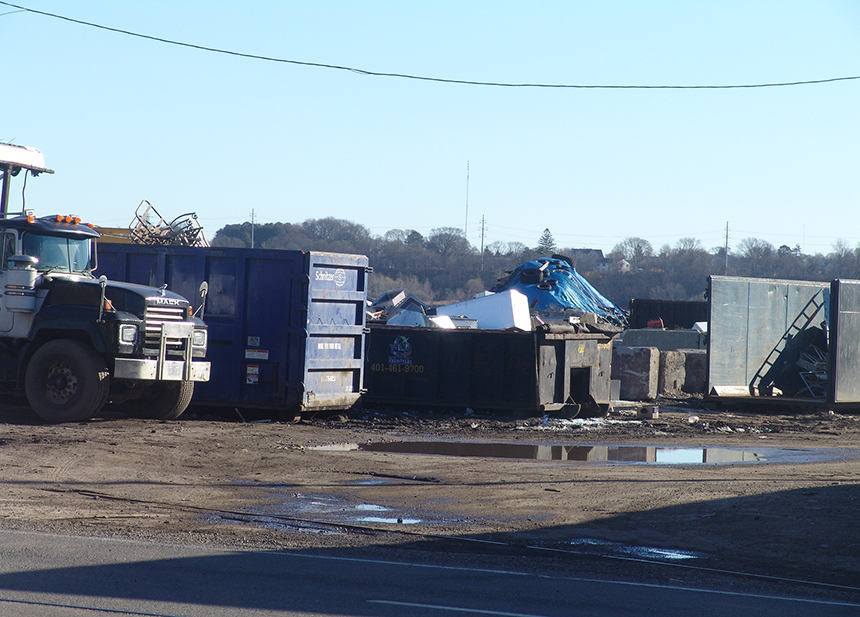
History keeps repeating
In a 2017 letter to Raimondo, No LNG in PVD claimed the then-proposed National Grid LNG facility “is unnecessary, risky, and short-sighted.”
“At a time when Rhode Island should be investing in renewable energy, improving coastal resiliency, and growing an economy of the future, this LNG facility would be a $180 million step in the wrong direction,” according to the seven-page letter.
Two months after that letter was sent, at a December public hearing hosted by the Coastal Resources Management Council (CRMC) board, National Grid’s tone-deaf project manager told the 100 or so attendees, many of them neighborhood residents concerned about health and climate impacts, that the new buildings will fit with the tan color scheme of neighboring structures.
An equally tone-deaf CRMC board member also comforted anxious residents by noting that the gas-cooling project’s visual impacts will be minor and that the 108-foot-tall tank containing a liquefied fossil fuel won’t stand out on the city’s increasingly vulnerable waterfront.
With little debate and no public comment allowed at the 40-minute public hearing, the CRMC board voted unanimously to approve the project. Silenced residents showered the CRMC board with disapproval and pleas, urging the members to reconsider. State and Capitol police shielded board members from the upset protesters and escorted them from the building — a symbolic sign that the well-being of eight politically appointed board members, none of whom live in South Providence or Washington Park, trumps the legitimate concerns of neighborhood residents.
Showing a similar lack of concern, FERC decided a comprehensive environmental impact statement wasn’t needed for National Grid’s latest LNG facility in the Port of Providence. All four commissioners approved the project. They noted that National Grid deserved the natural-gas cooling and storage facility because the multinational corporation wouldn’t make false claims about its need.
The decade-long defiance by Rhode Island Recycled Metals, though, best exemplifies the apathetic attitude officials hold for the health of South Providence, Washington Park, and upper Narragansett Bay.
Since 2009, the illegal business at 434 Allens Ave. has contaminated the Providence River and bay with polluted runoff and fuel from derelict vessels the company doesn’t have the authority to store. The business lacks proper permitting and has ignored cease-and-desist orders. All state and local officials do is shrug their shoulders and feign bewilderment that the business is still allowed to operate.
The 6-acre property, a heavily polluted site taxpayers already helped clean up once, originally became contaminated between 1979 and 1989, when state and local officials failed to regulate the computer and electronics shredding facility operating there. The waterfront site has since tested positive for toxins such as polychlorinated biphenyl, a carcinogen commonly used in electronics.
Perri called the polluting business a “greedy pig.”
“I don’t understand why they can’t be shut down,” she said. “Put a bulldozer in front of the entrance and tell them they are done polluting.”
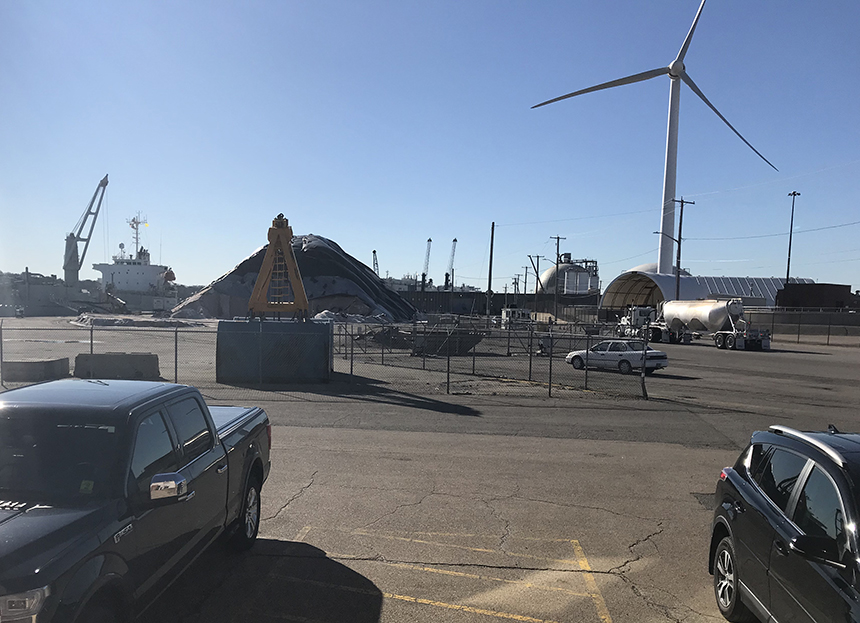
ProvPort changes
Past and present elected officials have done little to mitigate the port’s well-documented pollution problems or help prepare it for 21st-century challenges. In fact, it could be argued that they have been at best nonchalant about the neighborhoods’ woes and at worst complicit in creating them.
While it’s well documented that they did next to nothing during the port’s recent LNG controversy — 11 elected officials did sign on to an August 2017 letter No LNG in PVD sent to DEM expressing concern about the potential release of contaminants by pile driving and digging at the polluted site; DEM noted that it can’t force National Grid to clean the site — other stakeholders are aware of the area’s health concerns and climate threats, including the economic advantage that comes with addressing them, and are working to lessen those impacts.
It’s not an easy task. Southern New England still needs heating oil, jet fuel, natural gas, diesel, asphalt, concrete, road salt, and cars. Coal? Not so much.
Waterson Terminal Services has embraced renewable energy at the expense of coal. The decision is based both on economics and the urge to be a good neighbor, according to Christopher Waterson, general manager of the family-owned port management company.
For much of the 2000s and early 2010s, ProvPort was a big player in the coal business. Between 2001 and 2014, for example, Waterson Terminal Services imported millions of tons of coal from across the globe for use in New England’s power plants.
Those power plants are going off line, and offshore wind development is gaining steam. ProvPort is positioning itself to be a regional leader in that rapidly growing industry.
As recently as five years ago, a 70-foot-high pile of coal visible from the East Bay Bike Path in East Providence and from the India Point Park Bridge in Fox Point sat on the 7-acre ProvPort lot. Today, there’s only enough coal on the lot to fill a Dumpster.
Waterson is planning on using that parcel to carve out more space for wind-energy development. Waterson Terminal Services and its six berths played a key role in providing the means to receive and assemble the components for the five-turbine Block Island Wind Farm.
In hopes of making ProvPort better suited to deal with the impacts of climate change, Waterson Terminal Services recently entered into an environmental certification program with Green Marine. The program is a voluntary initiative to surpass regulatory requirements within the maritime industry. It addresses key environmental issues using various performance indicators, such as lowering air emissions, spill prevention mitigation, better stormwater management, and minimizing community impacts.
“We are always looking for ways to improve our operations and joining a well-recognized sustainability program such as Green Marine will allow us to exceed environmental standards,” said Waterson, who is a member of the EPA stakeholders group and the “Building a Resilient Providence” community group, both of which are working to create programs and build dialogue that will help the city and port better navigate the challenges of climate change. “The clear criteria beyond current regulations will help guide our actions towards continually improving our environmental performance.”
Two years ago, when ProvPort expanded its footprint to a parcel across from Save The Bay, to export more cars, Waterson Terminal Services worked with the waterfront environmental advocacy group and CRMC staff to create a public walking path and public access to the shore.
ProvPort spent $2.5 million cleaning up the closed landfill off Allens Avenue. The space set aside for public use on that remediated parcel has become a popular urban spot for fishing and bird watching. The walking path can be accessed by driving through the Johnson & Wales University Harborside Campus and parking near Save The Bay headquarters.
Ten acres of the 15-acre site now called “parcel 288” are paved. The other 5 acres are home to public access space and vegetative buffers that slow and filter stormwater runoff.
“We’re trying to be good neighbors,” ProvPort spokesman Bill Fischer said. “We’re trying to be transparent about what we’re trying to do.”

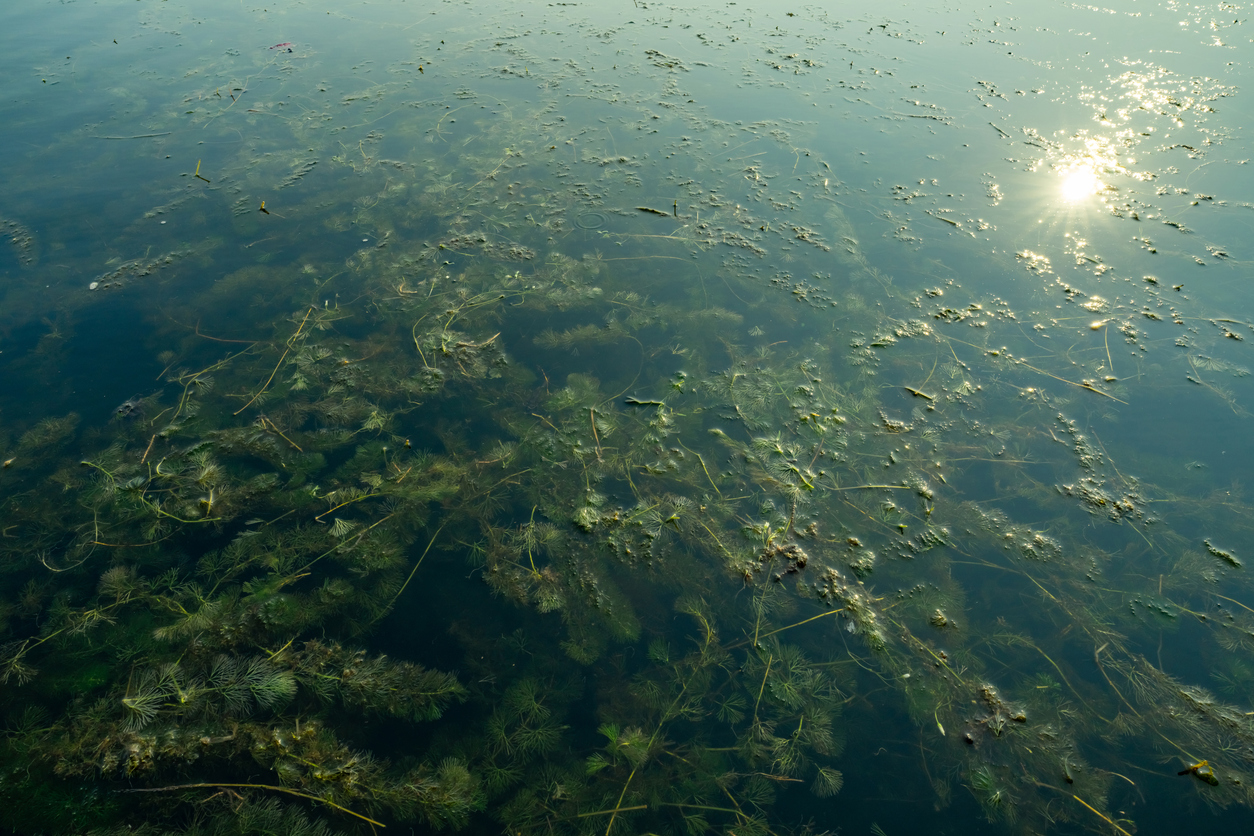
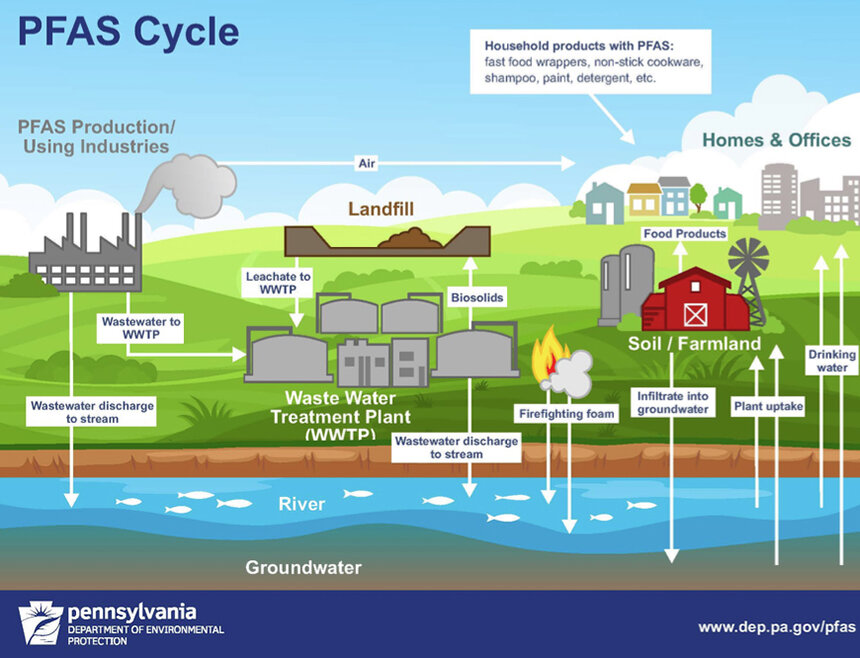
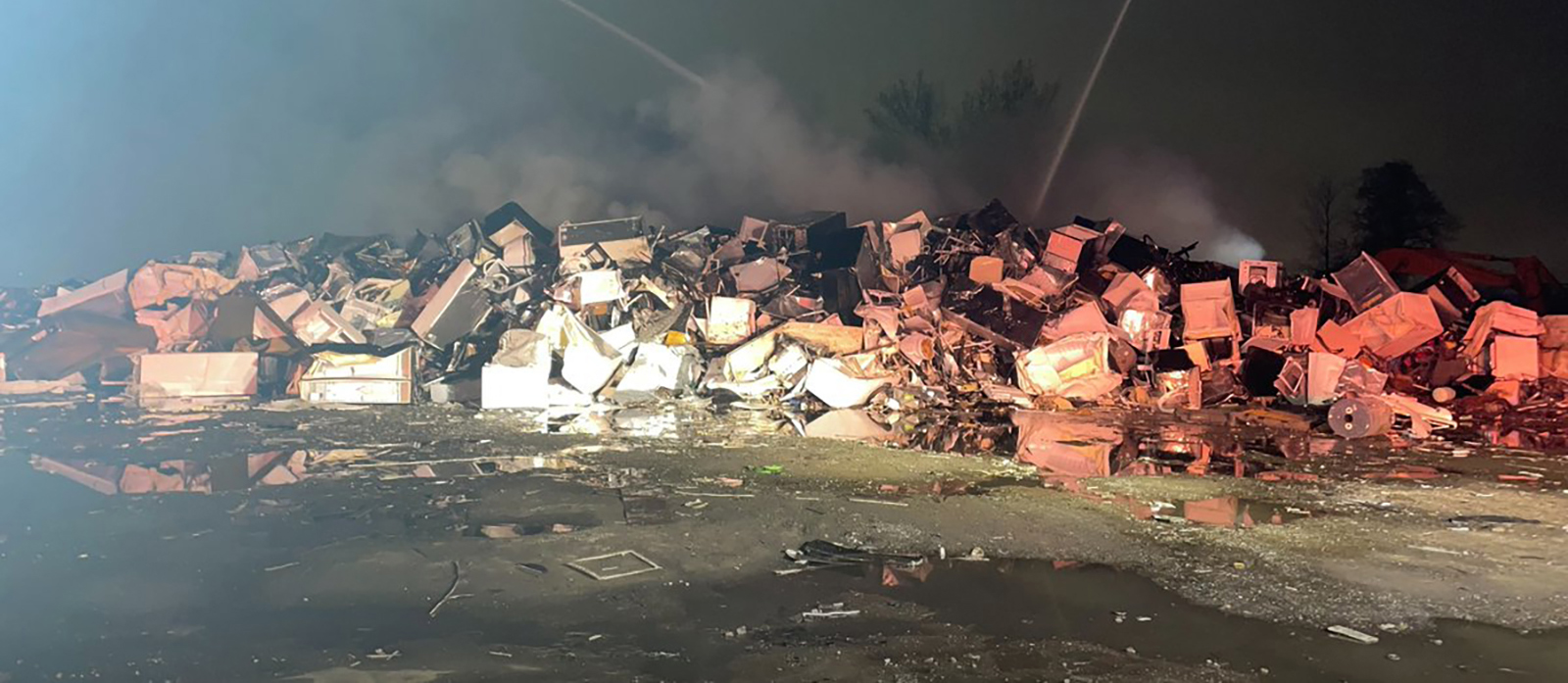
I WORKED AT THE RECYCLING PLACE ON ALLENS AVE. IN 1986(BOLIDEN METECH), THERE WAS A HAMMERMILL THERE THEN AND NEIGHBORES ALWAYS COMPLAINED ABOUT THE METAL BEING SHOT INTO THEIR YARDS FOR LIKE THREE MILES AWAY…LATER IN MY LIFE I HEARD THEY TORE IT DOWN BECAUSE OF PCB’S.
Where if anywhere would you put this industry? Scrap iron is a fact of life. We are not at the point where solar, wind, and water power generation of electricity can wean itself from fossil fuel. Atomic energy is a fallacy. With huge built in dangers and hazards. Building a four or five foot wall along the shoreline will only further endanger down river towns IE. Pawtuxet Village. and the Warwick low lying shore line. Capped hazardous waste is well known in the area Remediation is prohibitively expensive But It needs to be done . Sound pollution from scrap metal loading after dark is a Problem that East Providence across the river is exposed to it travels well inland. Again where would you put it.? I feel RI Government was short sighted in not taking full industrial advantage of Quonset Points, Deep water port. Air. Rail. and Nearby Highway service, I support clean up, and the possible public use of the area. Thanks for your article. John
People are ridiculous complain about everything . Life isn’t all sunshine and rainbows and pretty parks full of butterfly’s. That’s a picture of the working water front and we should embrace what’s left of it . I don’t here any complaints about the giant piles of salt that are used to make are roads safer all winter . If you want to talk about an eye sore take a boat ride on the Kill Van Kull around Staten Island, NY. Water front . The working waterfront provides good paying jobs to hard working men and woman something that seems to be disappearing here in America.
Wonderful summary of a serious, very longstanding problem which neither Providence nor the of Rhode Island seem to have/had the interest or guts to have said NO to their construction,,,as well as ongoing use. WHY? Also, you might note and comment on harm/potential harm emenating from the tank farms that are up the river in the NE Corner of the harbor.
This article is excellent and also an excellent example of racist environmental injustice. CRMC has always made irresponsible self-serving decisions, but RI DEM shares equal responsibility and is equally able to ignore citizens concerns and complaints.